Built in the 12th century, the Cairo Citadel still attracts sightseers as an iconic landmark in Cairo.
Standing on the Muqattam Hill, its location gives the visitors the chance of seeing a panoramic view of Cairo with its mosques, streets, buildings and the Giza Pyramids.
It was Salahuddin Al-Ayyubi (1176–1183 AD), who ordered the construction of the citadel as a fortress on that high hill. Its construction was finished later during the reign of Sultan Kamel ibn al-Adel (1207 AD) and remained Cairo’s seat for Egypt’s rulers until the 19th century, when it was moved to Abdeen Palace in downtown Cairo.
On entering the citadel, you forget the hustle and bustle of Cairo’s crowded streets. There is plenty of space and fresh air despite the summer heat. Despite being surrounded sometimes by tourists talking in different languages, you feel calm and tranquility as if you are alone in your own world.
Inside, you see people taking snaps of the landmarks there or even taking selfies.
Mohamed Ali Mosque
The Mohamed Ali Mosque is among beautiful monuments in the Citadel which was added to it in the 19th century. It was previously the site of Mamluk palaces.
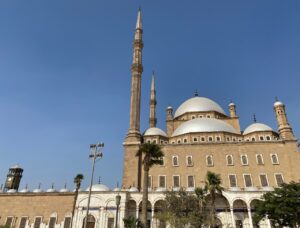
Mohamed Ali Pasha (1805 to 1848), who is known to be the founder of modern Egypt, commissioned the Turkish architect Yousif Boushnaq to design the mosque in the same layout as Sultan Ahmed’s in Istanbul.
The construction work started in 1830 until Pasha’s death in 1848.
The mosque is made of limestone, except for lower parts and the forecourt that are made of alabaster, which is why the mosque is also named the Alabaster.
The mosque consists of two sections, the outer is a vast open courtyard and the inner is the prayer hall.
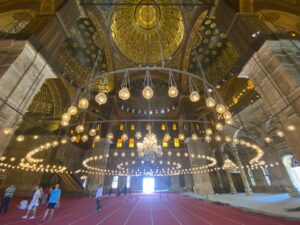
The majestic chandelier catches your eyes on entering the mosque. It hangs from the domed ceiling with dozens of lamps illuminating the prayer hall. I could see two workers standing on the staircase tirelessly cleaning these lamps from dust.
The floor is laid in red carpet. A few people are sitting in the corners or resting their backs on columns while reading the Quran.
Look at the 50-metre high ceiling. This magnificent upper interior surface is carried on four large arches. The huge central cupola is surrounded by four half cupolas, in addition to other four small domes covering the corners.
Mohamed Ali’s tomb is located inside the mosque. It is made of marble adorned with floral motifs and pointed and gilded inscriptions.
There are two minbars (pulpits) — one is original that is made of wood and covered in green with gilded decorations, the other is marble that was added in 1939 by King Farouk.
Leaving the inner part of the mosque to the outer atmosphere where the open courtyard is truly a great experience.
Opposite the exit door of the prayer hall, you see a metal-decorated tower with a clock. King Louis Philip of France presented it to Mohamed Ali in 1846 in exchange for the latter’s present of an obelisk that was granted to France and now stands in Place de la Concorde in Paris.
Imagine, the clock never worked properly despite many attempts to repair it. But the good news is that its sound will be heard soon, as the ministry of tourism and antiquities is working to repair it in cooperation with France.
At this open courtyard you breathe the fresh air and spend beautiful time there, seeing the panoramic view of Cairo when you stand near the low wall.
You can see the Giza pyramids from there. Viewing Cairo from above is another interesting experience during this visit.
I imagine how the soldiers during the different eras observed the enemy coming from afar and how our soldiers prepared to wage war with them and save Egypt from danger. I hear the sounds of cannons, the moaning of wounded … but suddenly my imagination is interrupted by a security man shouting to two persons who were about to sit on that low wall, “No. It is forbidden to sit here”.
National Police Museum
“No entry without a face mask”, is a sign written in Arabic and English at the entrance of the National Police Museum in the Cairo Citadel. The atmosphere inside is totally different from the outer places in the citadel. But despite that, it is worth visiting especially if you are fond of crimes, i.e. learning about them, not committing them.
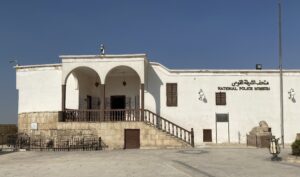


Receiving the visitors are life-sized models of policemen’ uniforms in the middle of the hall. Here is one that represents the Mamluk period, the Ottoman era and Mohamed Ali era, then the modern’s era. The first three are totally different from today’s uniform. Each one of those three wear a wide red belt made of cloth and a turban.
On the walls are photos of ministers of the interior in different periods.
The small museum makes you live with the famous stories of the criminals with their photos and how police captured them.
Sisters Raya and Sakina, whose crimes were cited in newspapers by killing 17 women in the early 1900s, are among these stories.

The sisters selected their victims who wore gold and jewels at markets in Alexandria. They persuaded the victim to accompany them to their home claiming that they have better goods. At home, a sister made a drink for the victim containing a substance that made her unconscious, then the other sister sneaked quietly behind the victim and put her hand over the mouth to prevent her from screaming, while the other criminal held her hands behind her back. Raya’s husband then held the victim’s feet and Sakina’s spouse wrapped a piece of cloth around the victim’s throat and suffocated her until she stopped breathing. The criminals removed her jewellery and buried the corpse inside their house. After a few days, the sisters went to the market to sell the gold and share the proceeds. The police were bombarded with reports of missing women. Later, they arrested the gang, who were put to death.
The museum also displays guns used in assassinations, such as the pistol which was used in the attempt on the life of President Gamal Abdel Nasser in 1954 by the Muslim Brotherhood terrorist group.
Citadel’s Prison
Leaving the museum to the nearby Citadel’s prison is another interesting experience. The prison dates back to the Mamluk era and was used for political prisoners, until the 1980s when it was turned into a museum.
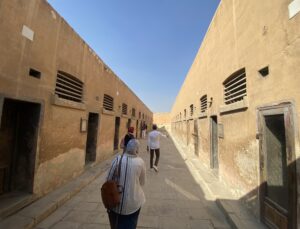
The prison corridor is about 50 metres long. On each side are a number of cells. Looking through the 10-cm hole in the iron door, you see the interior of the cell is very narrow. Its gloom makes you ready to confess to crimes that you haven’t committed!
President Mohamed Anwar al-Sadat was detained here; he was an army officer during the reign of King Farouk. He was held in connection with the murder of Amin Othman, minister of finance in October 1944. Sadat was eventually released when the real killer was arrested.
Citadel’s 14th century mosque
Sultans of Cairo used to perform Friday prayers at Al-Naser Mohamed ibn Qalawun Mosque, which was built by Sultan Al-Nasr Mohamed in 1318 on the site of an Ayyubid mosque.
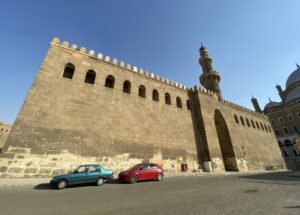
You may have visited the magnificent complex built by his father, Sultan al-Mansur Qalawun (1280-1290) in Muizz Eddin Ellah Street.
That multi-functional structure consists of a mausoleum, madrasa and hospital and is one of the major monuments in Mamluk architecture of Islamic Cairo.
Sultan Al-Naser Mohamed ruled Egypt three times between 1293 until his death in 1341. He fought wars against the Crusaders and Mongols. During his third reign, Egypt witnessed an urban renaissance unprecedented during the reign of any other Mamluk sultans.
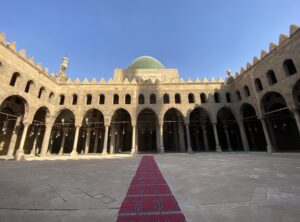
At the entrance to his mosque, take a moment to observe the features around you in this hypostyle-style mosque.
The interior is similar to the first early mosques, with an open courtyard surrounded by four porticos, the largest of which is the qibla. It is covered by a green cupola made of faience mosaics, resembling that of the Prophet’s Mosque in Saudi Arabia.
Unlike the Mohamed Ali Mosque, the floor is uncovered except for a long rectangular carpet from the entrance to the qibla portico.
The four porticos have small arched window openings overlooking the courtyard. The general layout of the mosque is somehow rigorous with simple decorations, the reason maybe because of its presence inside the fortress.
When you stand in the qibla portico and look up at the dome, you see it is supported by ten granite columns taken from ancient Egyptian temples. You notice the beautiful and different decorations of the columns’ crowns.
The wooden minbar is inlaid with ivory and mother‑of‑pearl.
The unique feature in this mosque is the two minarets with their distinctive details that are rarely found in any other mosques.
At their top, there are faience mosaics and a verse from the Quran inscribed in white on a blue background.
One may wonder why this mosque has two minarets. I learnt that there are two muezzins working at the mosque, each one standing in a minaret balcony, and proclaiming together the call to the daily prayer five times a day. Their loud voice can reach the whole area of the citadel, which included at that time barracks and sultanate palaces with their denizens. The mosque accommodates 5,000 worshippers.
Al-Naser Mohamed ibn Qalawun is not the only mosque in the Citadel. In addition to Mohamed Ali’s, there is also Suleiman Pasha al-Khadem, the first Ottoman-style mosque in Egypt. It was built in 1528 by Ottoman ruler Suleiman Pasha al-Khadem. But it is currently closed due restoration work.
What about putting on a Mamluk or Ottoman costume and getting photographed? An exciting idea, isn’t it? You can do this not at the mosque for sure, but at Kodak studio on your way to the exit of the Citadel. It is a wonderful souvenir for you of this historical landmark in the Egyptian capital.



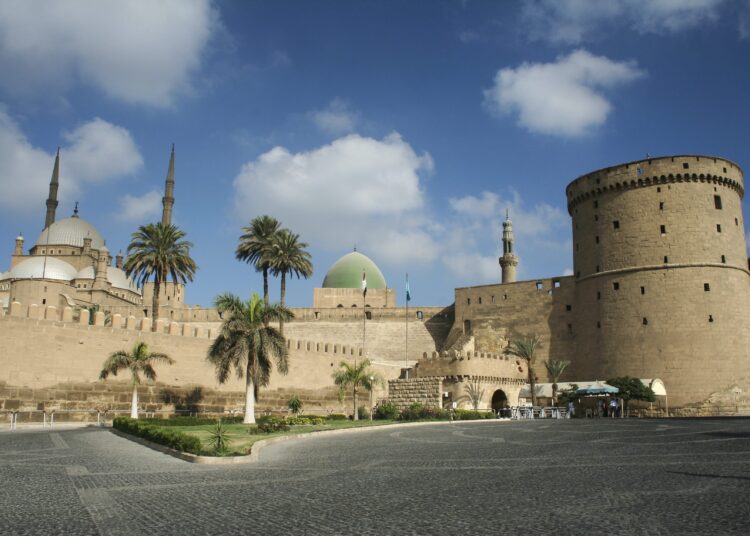


Discussion about this post